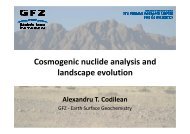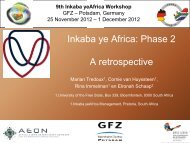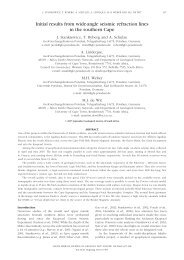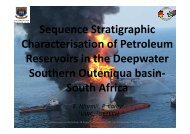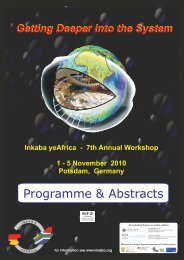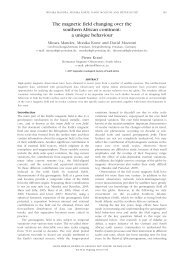South Africa - Inkaba.org
South Africa - Inkaba.org
South Africa - Inkaba.org
You also want an ePaper? Increase the reach of your titles
YUMPU automatically turns print PDFs into web optimized ePapers that Google loves.
Karoo sequence stratigraphy and facies modelling for<br />
improved reservoir characterisation and upscaling<br />
Mikes, Daniel 1<br />
1 Department of Earth Sciences, Stellenbosch University, <strong>South</strong> <strong>Africa</strong>, mikes@sun.ac.za<br />
ABSTRACT<br />
The overall aim of this project is to better understand the internal architecture of deltaic systems and the main research<br />
question concentrates on the response of the deltaic depositional system to internal and external forcing. Sedimentary<br />
systems are traditionally described using well-established techniques on three discrete scales: (1) Bedding analysis; (2)<br />
Facies analysis ; (3) Basin analysis. But to date there is no adequate method for describing 4D behaviour of a<br />
sedimentary system. It seems that the third spatial dimension might be a critical factor in addressing the issue. Our pilot<br />
studies of physical experiments show that 1D/2D sections from an artificial delta system show great variability and<br />
ambiguous interpretation, but they give us insight into proper interpretation of the rock record in the field.<br />
The focus in the fieldwork has been on the Pienaarsfontein se Berge, presumably exhibiting a sequence of 13<br />
depositional cycles deposited by shelf-edge and shelf-margin deltas. These depositional cycles consist of a variety of<br />
facies resulting from tidal, wave, current, storm and gravity processes. The existing facies models seem to be<br />
inappropriate, simply because they assume the passive margin terminology of a continental shelf – continental slope –<br />
oceanic basin. The Tanqua Depocenter is an intracratonic basin and seems to form a transition from shelf – shelf-margin<br />
–slope – continental basin.<br />
By (re)constructing an adequate facies model for this depositional system we intend to demonstrate three things: (1)<br />
existing facies models are inadequate and (2) adequate facies models are unique. By doing so we will also demonstrate<br />
that proper analysis of a sedimentary system is still the crucial and most powerful tool of a sedimentologist. The pilot<br />
study shows that this approach is promising.<br />
We will use the results from this study to improve on the building of a geological model, fundamental element in a<br />
reservoir modelling study, in its turn crucial to the production estimate. We will implement our findings into an<br />
upscaling procedure that we propose and will test against existing upscaling procedures on a producing reservoir.<br />
Numerous students involved in <strong>Inkaba</strong> will continue to work on different aspects of this work, largely falling into three<br />
categories: (1) conceptual facies models for sedimentary systems, (2) geometrical geological models, (3) reservoir<br />
characterization for use in upscaling and flow simulation.<br />
KEYWORDS: sedimentary systems, geometrical geological models, upscaling, reservoir characterisation<br />
55



